Presenze protestanti nel primo femminismo italiano
Protagoniste ed esperienze tra ’800 e ’900
Abstract
How did Protestant women mobilize themselves for the emergence of Italian feminism in the nineteenth and early twentieth centuries? The present article examines the involvement and activity of Protestant women up to the National Women’s Congress of 1908, when a rupture took place with the Catholic women, for whom the congress signalled the start of their own activity. While scholarship has shown how, also in Italy, the involvement of Protestant women within the structures of a nascent feminism was decisive, until now no synthesis was available. The story begins with the legal integration of religious minorities in the wake of the adoption of the Albertine Statute (1848) and, more generally, the rise of the liberal currents of the Risorgimento (“The Resurgence”), whereby Italian Protestant communities came to associate themselves with the process of national unification and the demands for profound social, cultural, and political reforms in Italy. It was on this domain that Italian Protestant women, while retaining good relations with other Protestant women in Europe, began to identify themselves with the claims of feminism and worked to advance the emancipation of women made possible by the modernization of public life. Over the course of time, liberal and democratic intellectuals, the early representatives of feminism and several members from the Protestant communities, began to grow closer together, as can be seen in the propagation of the Froebelian pedagogical method (which was based on the coeducation of girls and boys, as well as a non-confessional curriculum) and in the struggle for the abolition of the public regulation of prostitution. While this first phase saw no real feminist leaders arise from among the ranks of the Waldensian church, the remarkable story of Lidia Poet reveals how important the education and training of women in this context really was. As the second woman to obtain a university degree (in 1881) following the Italian Union, she was never able to exercise the legal profession and became a symbol for the demand for the emancipation of women. The end of the nineteenth century saw the foundation of the Young Women’s Christian Association (1894) and the Girls’ Friendly Society (1895) which, after meeting certain difficulties, both chose to incorporate themselves into the Consiglio nazionale delle donne italiane (CNDI), the largest and most moderate of Italian feminist associations. They participated in the National Women’s Congress organized by the CDNI in 1908. When the congress turned to address confessional education in primary schools, the Protestant representatives voted together with the radicals, socialists, and moderate laics in favour of the abolition of confessional education. The Catholic women, on the other hand, cut off all collaboration and chose to establish their own Unione fra le Donne Cattoliche d’Italia.
